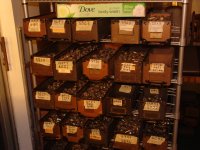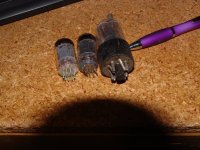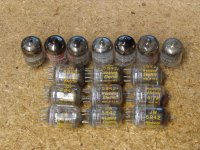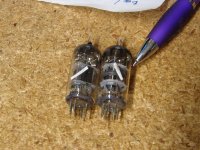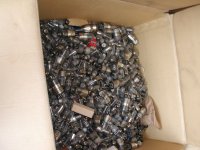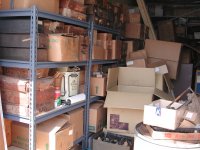I use emery paper strips to buff my tube pins shiny. I then wipe them with IPA that has a small amount of DeoxIT dissolved in it.
The paper I use feels smooth, not gritty to the touch, and it leaves no striations on a surface I buff with it. Not sure what grit number it is.
Sounds like it is fine to use then. I like the idea of incorporating De-Oxit as well. I bet that it picks up left over particles from the pins. At times, I will use a small buffing attachment with my Dremel after cleaning.
composite cleaning pens ( carbon fiber or glass fiber ) work well for cleaning pins pcb's contacts & no annoying bits in your fingers
Now that we have the tubes' pins nice and shiny, how do we get the socket receptacles that way?Sounds like it is fine to use then. I like the idea of incorporating De-Oxit as well. I bet that it picks up left over particles from the pins. At times, I will use a small buffing attachment with my Dremel after cleaning.
I have been hearing about people taking their electronics to the carwash. Um, no there are better ideas for sure. Main thing about tube sockets is that they get loose and cause havoc that way. Seems that I saw a sort of pipe cleaner type thing for them though.
I've used Nevr-Dull for over 55 years and the can is my fathers. It's a cotton wadding for polishing just about
anything. You take a wad of Nevr-Dull place it on a piece of styrofoam and plunge the valve into the wadding
6-10 times and wipe it off. There is zero removal of material, it polishes what is there and leaves a very light
lubricant on the pins you can clean by plunging them into clean cotton balls. A wad of Nevr-Dull will do many
valves. Put the used wads in a separate tin if they are not totally black.
Run the pins into a pin straightener and you're done. Don't wipe the barrel of the valve it CAN wipe off the tube
ID.
Pin sockets, pipe cleaners and a little mineral spirits or WD40. Rislone is another great non abrasive cleaner.
It smells like gun oil. I've pulled 1000 lifters that were stuck in lifter bores. 30 seconds later they were removed
unless they had a burr.
You should see it on the old stainless grills and bumpers. Chrome on the old Macs never looked so good, but ZERO
abrasion or parent material removal. I think the Army used the stuff at least they did up to 1976.
anything. You take a wad of Nevr-Dull place it on a piece of styrofoam and plunge the valve into the wadding
6-10 times and wipe it off. There is zero removal of material, it polishes what is there and leaves a very light
lubricant on the pins you can clean by plunging them into clean cotton balls. A wad of Nevr-Dull will do many
valves. Put the used wads in a separate tin if they are not totally black.
Run the pins into a pin straightener and you're done. Don't wipe the barrel of the valve it CAN wipe off the tube
ID.
Pin sockets, pipe cleaners and a little mineral spirits or WD40. Rislone is another great non abrasive cleaner.
It smells like gun oil. I've pulled 1000 lifters that were stuck in lifter bores. 30 seconds later they were removed
unless they had a burr.
You should see it on the old stainless grills and bumpers. Chrome on the old Macs never looked so good, but ZERO
abrasion or parent material removal. I think the Army used the stuff at least they did up to 1976.
I have tried Magic easer for the pins myself just as you said by poking the tube into the Magic Eraser block. I will even wiggle it around, but i don't see a lot of good that it does. I have done the same thing with a steel wool pad, and that will brighten the pins. I use a fine steel wool though. Maybe even an ink pen eraser would have some effect.
Steel wool and most erasers, tooth paste, brasso, Mothers polish work great, BUT they do remove parent material.
I used a lot of Emery cloth and steel wool deburring engine blocks, heads, rods, anything that had burrs or caught
a cloth was fair game. 🙂
I used a lot of Emery cloth and steel wool deburring engine blocks, heads, rods, anything that had burrs or caught
a cloth was fair game. 🙂
So it depends on the condition of the pin and how much you want to remove without trouble. Most pins are fine with just a good polishing. Now I wonder, is it desirable to stick tube pins down into an ultrasonic cleaner normally used for jewelry? This could get interesting guys.
Using any acid such as acetic acid from lemons, or any other chemical action can be done as long as it doesn't take/pit the surface that you are trying to clean. Whatever soap or other ingredient will also leave its mark if it is too stringent. If a pin is relatively clean to begin with, I like the idea of polishing it for best contact surface.
The sockets OTOH could be a more difficult issue and if you go in that far into a circuit, it would be tempting to me to replace the socket with one that is superior to the one in place. There are few designs that are more reliable for constant pin contact/pressure.
The sockets OTOH could be a more difficult issue and if you go in that far into a circuit, it would be tempting to me to replace the socket with one that is superior to the one in place. There are few designs that are more reliable for constant pin contact/pressure.
?I have put sockets in my dishwasher, works great, and veeeeery easy.
Try to cook the sockets in ater with baking soda
just few minutes when boiling start.
.
You can use wet linen with baking soda powder to clean pins too.
I once had 20+ boxes like these, but in much worse condition. The large round drum is full of tubes. All had been stored in an abandoned warehouse in Florida with all of the windows broken for at least 15 years. Vagrants, vandals, homeless and druggies had used the place for their misdeeds over the years as there were broken tubes and excrement (bird and otherwise) everywhere. I moved them all 200+ miles to my little warehouse and it took me about 5 years to clean and sort them all and then sell, trade, give away, or trash the stuff I would never use. There were quite a few useful tubes with nasty pins. Some could be saved, but some like the octal 7193 in the picture were beyond help as the pins had been crushed and broke off when straightened. In most cases the cleaning was accomplished with some WD-40 and a toothbrush after straightening the pins with needle nosed pliers and a plug in pin straightener. Some useful but nasty looking tubes had to be soaked in a solvent first, usually alcohol or mineral spirits.
There were some gems hidden amongst all of the dirty rocks, and a few oddities. Ever see a tube with a spare heater inside? What are the odds of finding TWO of them?
There were some gems hidden amongst all of the dirty rocks, and a few oddities. Ever see a tube with a spare heater inside? What are the odds of finding TWO of them?
Attachments
You found treasure alright, but not without a price. One thing though, after dealing with that many tubes and pins likely you found the best way for you to clean them. Usually it is a one by one sort of job. Trying not to take off the tube printing/label would be a concern of mine.
Fortunately, most of the tubes with some monetary value like the Western Electric tubes in the picture were relatively clean and good looking. The needed minimal cleaning and the logo printing survived. There were also about 20 Raytheon 5842's that were not so nice. Some of them are completely naked now due to the effort and solvents needed to remove some crusty brown coating that covered many of the tubes. They all work in a test amp though, and for me, that's all that counts.
The tubes that had remained in closed boxes for their time in that warehouse were mostly clean, but unsorted. Most of the boxes had damage from water, rats, mice and roaches, and humans. Some had completely disintegrated, spilling their contents on to rusty corroded shelving or the concrete floor. Many of these went directly into the trash dumpster outside. It seems that some of the human inhabitants in the building liked to smash most of the big tubes. There were dozens of broken 833A's 211's, 845's, and 813's along with a few biggies like 4-400's and a 4-1000 or two.
Someone in the team originally contracted to clean up the warehouse so that it could be demolished spotted "hazmat" and declined the job......after removing several truckloads of vintage aircraft parts. I got 4 consecutive weekends to take what I wanted before the "hazmat' team that could remove the mercury from all the smashed MV rectifier tubes showed up.
Looking back now, I probably spent more in warehouse rent to store all of those tubes than they are worth, not to mention all the time that went into sorting and cleaning. They were however the catalyst that kickstarted Tubelab, so maybe it was worth it.
The tubes that had remained in closed boxes for their time in that warehouse were mostly clean, but unsorted. Most of the boxes had damage from water, rats, mice and roaches, and humans. Some had completely disintegrated, spilling their contents on to rusty corroded shelving or the concrete floor. Many of these went directly into the trash dumpster outside. It seems that some of the human inhabitants in the building liked to smash most of the big tubes. There were dozens of broken 833A's 211's, 845's, and 813's along with a few biggies like 4-400's and a 4-1000 or two.
Someone in the team originally contracted to clean up the warehouse so that it could be demolished spotted "hazmat" and declined the job......after removing several truckloads of vintage aircraft parts. I got 4 consecutive weekends to take what I wanted before the "hazmat' team that could remove the mercury from all the smashed MV rectifier tubes showed up.
Looking back now, I probably spent more in warehouse rent to store all of those tubes than they are worth, not to mention all the time that went into sorting and cleaning. They were however the catalyst that kickstarted Tubelab, so maybe it was worth it.
Tubes of monetary worth ??
Had a phono repair come in the other month and quickly found the issue was corroded & pitted pins of an E80CF tube which is mean´t to have more value than it´s equivalents, now basically written off. I find this pitting odd as gold plating should be immune to all common solvents etc as Philips/Valvo did use gold plating, not any other metal.. However, the previous owner or someone in the past obviously overly hard brushed til much was plating was removed, so we get an intermittant heater and very noisy anode connection.
When this 1969 made tube finally made contact, the emission was as good as new. Sadly the only way to guarantee proper operation is to carefully solder the kovar pin ends with fresh; with the tube upside down held in a beaker of water just covering the pin/base to quench the solder heat ...not without difficulty.
Over the decades, many bad pin issues going through my bench was more confined to the poor soldering in the IO bases.
Don´t over-do the cleaning ! but as I am from the steam era, it does make me frown the many good tubes stored in lofts and lock-ups that still get hulled out....shame on society.
Bench Baron

Had a phono repair come in the other month and quickly found the issue was corroded & pitted pins of an E80CF tube which is mean´t to have more value than it´s equivalents, now basically written off. I find this pitting odd as gold plating should be immune to all common solvents etc as Philips/Valvo did use gold plating, not any other metal.. However, the previous owner or someone in the past obviously overly hard brushed til much was plating was removed, so we get an intermittant heater and very noisy anode connection.
When this 1969 made tube finally made contact, the emission was as good as new. Sadly the only way to guarantee proper operation is to carefully solder the kovar pin ends with fresh; with the tube upside down held in a beaker of water just covering the pin/base to quench the solder heat ...not without difficulty.
Over the decades, many bad pin issues going through my bench was more confined to the poor soldering in the IO bases.
Don´t over-do the cleaning ! but as I am from the steam era, it does make me frown the many good tubes stored in lofts and lock-ups that still get hulled out....shame on society.
Bench Baron
There was talk of chemistry process going on if the gold tube pins are put into ordinary socket - over ( long probably ) period of time so called diode-effect can occur because contact materials are not the same and gold plating is thin.
So recommendation was to use gold plate sockets with gold plated pins and for ordinary tube pins ordinary sockets.
I assume that it really takes a long time for this process to happen - had used E180F with gold plated pins in ordinary plated socket ( nickel mix ? ) for a year+ and nothing happend to tube pins when i changed the tube for ex-Soviet 6Z9P-E / 6J9P-E ( no gold plated pins ).
So recommendation was to use gold plate sockets with gold plated pins and for ordinary tube pins ordinary sockets.
I assume that it really takes a long time for this process to happen - had used E180F with gold plated pins in ordinary plated socket ( nickel mix ? ) for a year+ and nothing happend to tube pins when i changed the tube for ex-Soviet 6Z9P-E / 6J9P-E ( no gold plated pins ).
- Home
- Amplifiers
- Tubes / Valves
- Cleaning oxidised tube pins

